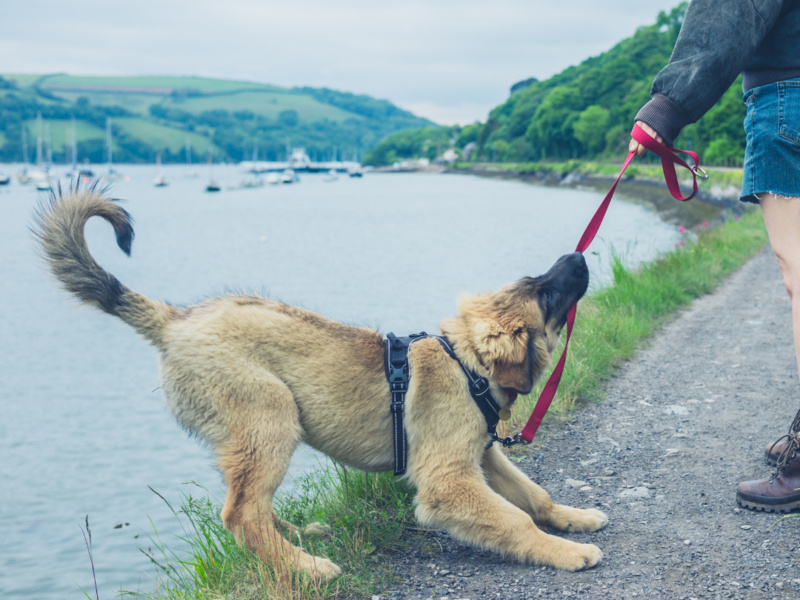No More Walk Reactivity: 3 Essential Skills to Teach Your Dog by Anna Hope
You’re heading out for a walk and you’ve got your dog ready, their harness is on and you’ve just clipped the lead on. You’ve got your stuff ready too, poo bags, treats and a waterproof in case it rains as it’s predicted to.
You head to the door and open it, out you both go and you lock the door behind you.
Before you even get to the end of your driveway, you’re worried.
You grip that lead a little tighter, you constantly look around for anyone or anything that might be coming your way.
You carefully head down the street hoping that nothing comes round the corner.
Then you remember all of the times you’ve had to dive in a bush or behind a car to get out of the way of an oncoming dog, because your dog is reacting more than you’d like.
But nowadays it isn’t just when your dog’s reacting that you’re feeling stressed and anxious. You’re anxious as soon as you walk out of the front door.
Walks aren’t meant to be like this. This isn’t what you signed up for and you don’t want it to feel like this every time you walk your dog.
This feeling of anxiety, guilt and stress wasn’t the reason you wanted a dog. It was for the long care-free walks, the time to switch off and the fun of having a furry companion by your side to enjoy it all with.
If anything above resonates, I’ve got 3 things to teach your dog right now to help.
What does a reactive dog look like?
Usually, they show signs such as barking, lunging, spinning on their lead, pulling on their lead, running off, biting the lead, biting your trousers, staring or being fixated or not wanting to move once they’ve spotted something.
Sound familiar?
Your dog doesn’t have to do all of the above to be considered a dog that reacts on walks. They could do one or two or all and it would still mean they could be classed as a dog that reacts.
It could be they react to everything on your walk and the severity of those reactions are high, or you might see just one or two of the suggestions above happen but they do them lots. Where ever your dog sits on the reactivity scale, teaching your dog some skills to help focus them will definitely be a good shout.
Why do dogs react?
There are lots of reasons a dog may react on a walk and sometimes it is hard to pinpoint the exact one. Dogs aren’t robots, they’re living organisms where there are so many variables at play which impact on how they behave.
To help narrow it down and to give a starting point, I’ve got some of the main areas I’ve found over the last decade of training dogs below for you.
- Fear: Dogs may react to things they are afraid of, such as other dogs, people, or loud noises. They’re literally scared at the sight or sound of these things and it makes them jumpy on the lead.
- Excitement: Dogs may also react to things they are excited about, such as other dogs, squirrels, or food. This can make them animated on the lead or vocal as they just can’t handle the excitement build up.
- Anxiety: Dogs who are anxious may react to things that they perceive as a threat, such as other dogs, people, or loud noises. Again, to either the sight or sound of these things.
- Frustration: Dogs who are frustrated may react to things that they want but cannot have, such as other dogs, squirrels, or food and this frustration comes out with barking, pulling or being very bouncy on the lead.
- Pain: Dogs who are in pain may react to things that make them feel worse, such as other dogs, people, or loud noises. If you have an ear ache, the last thing you want is another dog sniffing your head.
My dog reacts, where do I start?
The first step is always to look at safety for you, your dog and others around you. Be realistic and firstly make sure you are using the best equipment for your walks to help.
If your dog reacts by pulling you on the lead and it can be quite difficult to hold them back, use a harness with a front clip or for giant breeds, a well fitting (not restrictive and tight) head collar, such as the Dogmatic.
If your dog reacts to other dogs and always runs to them, do not allow your dog off lead and use a long lead instead, to ensure they cannot run off to another dog.
Put systems in place to ensure everyone is safe first before you begin to address this.
What next?
The next step is to identify what triggers your dog. You need to be really specific here and simplify it. If your dog reacts to dogs that’s not enough information.
Is it dogs on lead, off lead?
Bigger dogs, smaller dogs?
Dogs that bark or don’t bark?
Dogs you’ve met before?
Dogs that are on the other side of the road or dogs closer?
Only dogs that come close?
The more specific you can be, the better for understanding how to help your dog.
Once you’ve identified what potential triggers your dog has, you can be on the look out for them. When you see something that could trigger your dog, this is your cue to grab their attention before they react.
3 Essential skills to teach your dog to help reduce their reactivity.
Over the last decade I have been lucky enough to work with hundreds of dogs and their owners and it’s given me the chance to simply this stuff. I have found I always go to three skills that give the dogs something else to do but also give their owners something to do to help their dog not react in the same way as they always would have before.
There are lots of ways to teach this and lots of different ways to help a reactive dog, but these have been my top three over the years.
- Knowing their name!
Sounds so simple right? But basically, this is teaching your dog to look up at you when they hear their name. When on lead this is ideal as it means you’ve got their eyes on you and if their eyes are on you then their ears are too. Teach them to focus on you when they hear their name and it gives you a chance to walk past/away from whatever it is that triggers your dog.
- Catch!
If your dog likes toys or likes to hold something in their mouths, a catch can be a really good way to grab their attention when you need it. You’re not throwing something far, literally just to their mouth but when they ear ‘catch’ they’ll instantly look up at you ready to catch whatever it could be. A soft toy is always a good shout as it’s easy for them to hold in their mouths.
Extra tip: it doesn’t matter if they can’t catch and it drops, the point of this is that when they hear ‘catch’, they look at you ready. If they catch it it’s a bonus!
- Let’s go this way!
Essential for anyone with a reactive dog as this is your chance to spin your dog on the spot, move away from the trigger and make it a GOOD thing for your dog. If you’ve ever tried to move your dog from their trigger and found they look back, bark or pull to it anyway, this is ideal for you.
It means you can safely turn them around and walk away from the trigger, without your dog becoming worked up. Teach them to turnaround with you when you say something like ‘this way’ and keep them walking. They’ll soon know that turning around quickly isn’t a bad thing. It’s a good thing. When they can easily move away from triggers without a reaction, that’s a big move towards helping them to react less.
I hope these have been helpful for you and your dog. Reach out to me if your dog reacts, happy to see if I can help. Sometimes that first call for help is the hardest as the task at hand feels like an epic mission.
It doesn’t have to be.
It can be simple and easy.
Just grab the help if you need it.
Tell me what your dog reacts to:
Hey, I'm Anna. A dog trainer and Mum from Rugby who helps people train their dogs to be the BEST family member. A content, happy & well trained dog = BLISS.
Fancy knowing how to train your dog FASTER & BETTER?
With accuracy and without confusion?
Grab my easy 5 minute guide HERE

